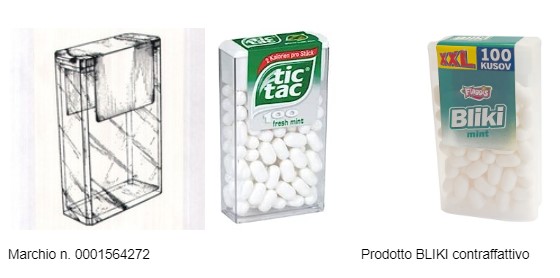We have created an interactive tool that gives you the opportunity to get a customized quote.
CALCULATE THE QUOTE
In a recent ruling (No. 12881 of May 11, 2023), the Italian Supreme Court reiterated its opinion on shape marks and their peculiarities.
We previously discussed shape mark and the difference with position mark in the article Position trademark and shape trademark: the Louboutin case.
In this article we will consider:
The case at hand pitted the Italian company Ferrero SpA and the company Mocca spol sro against each other regarding the infringement of Italian trademark No. 0001564272, representing the well-known packaging of Tic Tac® candies:

Since the packaging was protected by both a trademark and a patent, a key issue was to understand whether the technical features of a product, protected by a patent, could affect the validity of trademarks registered to protect the aesthetic features of the product.
The lower courts ruled that the technical characteristics of a product and its aesthetic characteristics are mutually independent, and the registration of a trademark cannot be invalidated by the mere presence of a patent.
This implies that a product can be registered either as a trademark in order to protect the aesthetic form of the product or as a patent in order to protect technical innovations.
The plaintiff argued that both territorial courts had provided an incorrect interpretation of Article 9 of the Italian Industrial Property Code (IPC).
Said article, albeit negatively, delimits the scope of protection of the so-called shape trademark. Specifically, Article 9 provides that signs consisting of:
The rationale of the article is to prevent non-distinctive but exclusively functional and technical forms from being the preserve of the exclusivity of a single trader.
The plaintiff’s contentions are based on (2). As a matter of fact, Mocca spol believed that the mark at issue consisted exclusively of a shape necessary to achieve a technical result.
The Italian Supreme Court disagreed, as we shall see in the following paragraphs.
In its decision, the Italian Supreme Court focused on the fundamental distinction between the concepts of “necessary shape” and “substantial shape.”
The former refers to a shape that is essential to obtain a technical result and thus functional, because it is imposed by the industrial utility it pursues. Hence, when the shape is “necessary” – that is, inseparably connected with the utility of the invention – imitation is permissible.
Conversely, substantial shape is defined as that which gives substantial value to the product; in other words, it adds value to the product without changing its function.
Given this distinction, case law has ruled that a sign, such as the shape of a product, can be registered as a valid trademark only if it is capable of distinguishing the product or service of one firm from that of other firms and is not merely a form necessary to achieve a technical result or one that gives substantial value to the product.
In making its decision, the Court also emphasized the differences between technical and aesthetic characteristics to define the scope of trademark protection.
In the Court’s view, technical features, such as the opening mechanisms of a container, are different and separate from aesthetic features, such as the shape of the container itself.
This is a fundamental distinction in order to understand the role of trademarks and patents in protecting intellectual property. For while a patent protects a product’s functional or technical innovations, a trademark serves to identify and distinguish the product in the marketplace, often through elements such as shape and appearance.
According to all the above and the aforementioned differences, the Italian Supreme Court considered Mocca spol’s appeal inadmissible. As a matter of fact, according to the ermines (Italian Supreme Court judges are called “ermines” due to their red, ermine-lined robes with golden striped hat), a three-dimensional trademark can protect both technical and aesthetic aspects and thus can be registered as both a trademark and a patent.
The existence of a patent designed to protect a particular product does not preclude the possibility of registering a trademark for the very same product, provided that the trademark meets the legal requirements for registration.
In the present case, the shape of the container of the well-known Tic Tac® sugared candies is not only a technical solution to a given problem, adding that this is confirmed by the sure possibility of the container taking other shapes, without functional prejudice to the purpose of containing and distributing the candies.
The case of the trademark in question is a prime example of how important it is to rely on the assistance of a professional in order to choose the appropriate instrument of protection for one’s invention and, at the same time, in order to understand whether what is devised may infringe the rights of a third party.